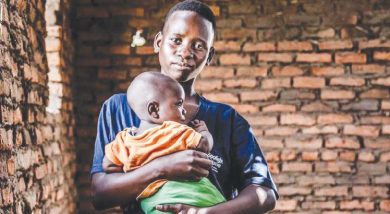Youths for climate justice
In Masanduku, a rustic village in the interiors of Chikwawa District, silted trails of chronic flooding split drought-stricken crop fields.
Born over a decade before liberation fighter Hastings Kamuzu Banda’s homecoming in 1959 and raised just when floods were far apart, Aline Kumwembe has lost count of her years and the times she has had to flee floods ripping her home in the Shire Valley.
However, the mother of nine, who forecasts the onset of rainy seasons from the sprouting trees, stays put in the floodplain where rising rivers point to recurring disasters.
Having witnessed furious floods flash past her grass-thatched house, she reckons that weather-related tragedies have become more frequent and destructive in the past three decades.

“I grew up without any doubt that my low-lying area is prone to drought and flooding, but such disasters are happening in quick succession these days. Times have changed. If not flooding, we experience prolonged drought,” says the woman, aged over 70.
Twice in the past five years, floods have shattered Kumwembe’s home. First was the raging torrent of January 2015, which forced her to flee to Konzere Primary School almost 10 kilometres away. In March 2019, tropical Cyclone Idai displaced the granny and her neighbours who sought shelter at Jese Primary School, disrupting learning yet again.
They returned home to rebuild shortly after scorching sunshine returned to the valley a week later, but their colleagues elsewhere were not as lucky. Some spent months in congested emergency camps during Cyclone Idai, which affected about 900 000 Malawians and displaced nearly 90 000, with worst counts in Mozambique and Zimbabwe.
Kumwembe is convinced that the younger generation could face more catastrophic disasters unless they take decisive steps to reduce the loss and damage caused by climate-related weather shocks.
She is convinced that everyday chores such as burning firewood and charcoal, disrupt rain formation and leave the Shire Valley without trees to block rainwater racing down the slopes. The run-off scrapes off fertile soil, burying rivers in silt. The Food and Agriculture Organisation (FAO) of the United Nations estimates that Malawian farmers lose about 29 tonnes of topsoil per hectare every year.
“The recurring floods and drought worsen hunger and poverty as crop yields are already dropping due to bleached soils. The food scarcity becomes heartbreaking when crops wilt or get swept away by floods,” she says.
The old-guard wants flood-prone communities to adapt to climate change and take disaster risk reduction measures instead of waiting for relief items when tragedy strikes.
Trocare is working with youth activists from Lilongwe University of Agriculture and Natural Resources to make vulnerable communities aware of the risks and solutions to chronic disasters.
Recently, the Students’ Network for Climate Justice, which is part of a growing youth movement against laxity in tackling the global crisis, stormed flood and drought hotspots in Chikwawa to disseminate climate change messages.
Alinafe Lidamlendo, who recently graduated with a Bachelor of Science degree in water and soil management, says the country’s rural majority have the power to lessen the devastation caused by climate change mostly fuelled by massive carbon emissions from wealthy nations since the industrial revolution.
The young graduate says it is a pity that poor nations pay a huge price though they emit less gases that fuel global warming, but simple steps like conserving forests, planting trees and using wood-saving cookstoves could help avert disasters.
She states: “As world leaders countdown to CoP26, the global crunch climate talks to be held in Scotland in October, rich nations should increase support for the poor worst affected by the effects of climate change.
“However, this doesn’t mean that we ourselves cannot do something about it. We need to accelerate efforts to reduce climate change, especially weather-related disasters. Let’s bring back the green cover and relocate from lowlands to uplands. We can also grow a diversity of crops, especially fast-maturing and drought-resistant varieties, to beat hunger and poverty.”
The students’ movement dials up calls by the likes of Swedish climate activist Greta Thunberg and Ugandan Vanessa Nekate for elders and world leaders to tackle climate change as an emergency.
For Lidamlendo, learning institutions constitute strategic rallying points for children to learn climate issues and join the frontline fight against global warming.
She argues: “If we, the youth, don’t take the lead, we will suffer the worst consequences of climate change because adults are not doing enough to combat climate change. “The business as usual attitude will affect us more because our generation has more years to live.
“When crop harvests fall, it’s the youth who go to school hungry or drop out because their parents cannot afford fees. When there are floods, learning stops because displaced people seek shelter in classrooms for months. This is why we deserve a listening ear.”
Philip Nyasulu, from Trocaire, says the youth have become handy in the push for climate justice as the lowest emitters of greenhouse gases suffer worse devastation than the big emitters.
“Everywhere we work, we engage the students’ network in advocacy and mass awareness because the youth do not only learn these things in school, but also experience the impacts of climate change in their homes. They are energetic and passionate to bring change for the benefit of their generation,” he says.
Trocaire also works with the Civil Society Network on Climate Change to advocate climate justice, transparency and accountability in the push for global sustainable development goal 13—tackling climate change.





